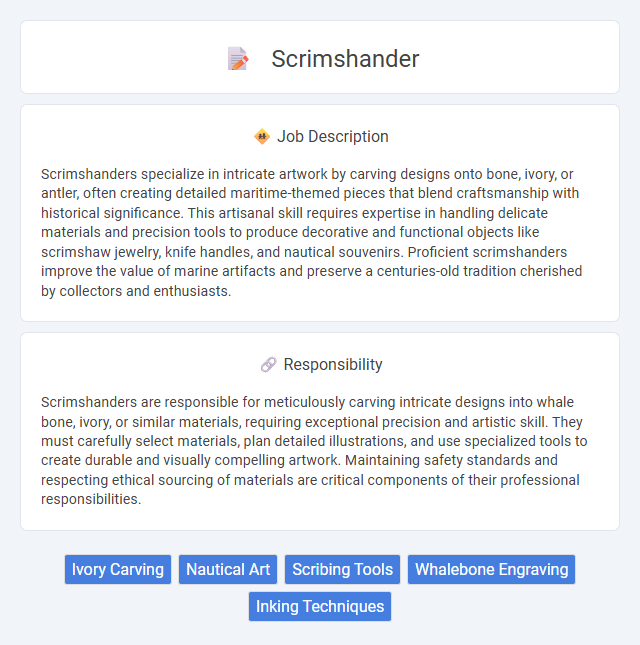
Scrimshanders specialize in intricate artwork by carving designs onto bone, ivory, or antler, often creating detailed maritime-themed pieces that blend craftsmanship with historical significance. This artisanal skill requires expertise in handling delicate materials and precision tools to produce decorative and functional objects like scrimshaw jewelry, knife handles, and nautical souvenirs. Proficient scrimshanders improve the value of marine artifacts and preserve a centuries-old tradition cherished by collectors and enthusiasts.
Individuals with steady hands and a strong attention to detail are likely to be well-suited for the scrimshander profession, as the work involves intricate carving on bone or ivory. Those who prefer solitary, focused tasks over fast-paced or physically demanding jobs might find greater satisfaction and success in this role. People prone to repetitive strain injuries or with limited patience for meticulous work may not be as compatible with the demands of scrimshandering.
Qualification
Scrimshanders require strong artistic skills with a focus on detailed engraving and carving on bone, ivory, or antler materials. Proficiency in using fine tools such as knives, chisels, and carving needles, along with a deep understanding of traditional techniques and historical motifs, is essential. Candidates often benefit from formal training in fine arts or apprenticeship under experienced artisans to master precision, design, and material handling.
Responsibility
Scrimshanders are responsible for meticulously carving intricate designs into whale bone, ivory, or similar materials, requiring exceptional precision and artistic skill. They must carefully select materials, plan detailed illustrations, and use specialized tools to create durable and visually compelling artwork. Maintaining safety standards and respecting ethical sourcing of materials are critical components of their professional responsibilities.
Benefit
A Scrimshander job likely offers unique benefits such as developing fine motor skills and artistic creativity through detailed carving work. There is a probability of working in a niche market that values handcrafted, personalized items, which may lead to high job satisfaction. Flexible working conditions and the potential for self-employment might also enhance the appeal of this career.
Challenge
Scrimshander jobs likely involve intricate craftsmanship that demands exceptional precision and attention to detail, making the work both physically and mentally challenging. The probability of encountering complex designs and delicate materials may increase the difficulty, requiring steady hands and patience. Those in this role might often face tight deadlines that add pressure to maintain high-quality standards consistently.
Career Advancement
Scrimshanders specialize in crafting intricate designs on bones and ivory, a skill highly valued in artisan communities and luxury markets. Mastery of advanced engraving techniques and knowledge of material properties enable scrimshanders to progress into positions such as senior artisans, workshop supervisors, or bespoke product designers. Career advancement often involves continuous skill refinement, building a portfolio of distinctive work, and gaining recognition through exhibitions or collaborations with high-end brands.
Key Terms
Ivory Carving
Scrimshanders specialize in the intricate art of ivory carving, transforming elephant tusks, whale teeth, and other ivory sources into detailed engravings and sculptures. This craft requires precision tools and mastery of techniques such as etching, inlaying, and shading to achieve lifelike representations or elaborate patterns. Skilled scrimshanders often work on custom commissions, producing collectible pieces that blend cultural heritage with fine craftsmanship.
Nautical Art
Scrimshanders specialize in intricate nautical art by carving detailed designs into whale bone, ivory, or antler, creating historically significant maritime artifacts. Their craftsmanship preserves seafaring traditions through motifs such as ships, marine life, and navigational symbols, blending art with maritime history. Mastery of scrimshanding requires precision tools and extensive knowledge of nautical themes, making it a unique and culturally rich profession.
Scribing Tools
Scrimshanders rely heavily on specialized scribing tools such as scalpels, needles, and fine chisels to intricately carve detailed designs into bone, ivory, or antler surfaces. Precision and control are paramount, so these tools often feature ergonomic handles and ultra-sharp tips to achieve delicate, precise incisions. Mastery of scribing instruments enables scrimshanders to create intricate, lasting artwork with exceptional texture and depth.
Whalebone Engraving
Scrimshanders specialize in the intricate art of whalebone engraving, transforming whale teeth, bones, and ivory into detailed, etched artworks and functional items. This craft requires mastery in carving fine lines and patterns that often depict marine life, historical scenes, or nautical themes, making each piece unique. Whalebone engraving serves as both a cultural heritage practice and a niche artistic profession, preserving maritime history through delicate, hand-engraved designs.
Inking Techniques
Scrimshanders employ precise inking techniques that enhance the intricate details carved onto bone, ivory, or antler surfaces. They utilize fine-tipped pens, brushes, and specialized inks to fill engravings, emphasizing texture and depth while preventing smudging or fading over time. Mastery of shading, cross-hatching, and stippling ensures the artwork maintains clarity and authenticity, reflecting traditional craftsmanship standards.
 kuljobs.com
kuljobs.com